Belisarius gave the basic method. I shall introduce an advanced method, because you seem eager to learn.
First let me say that I saw what I believed were simplifications to your code, and I made them, hopefully not in error.
I will use this sample data in illustrations below:
data = Prepend[
RandomInteger[99, {5, 12}],
DateString[{1, #}, "MonthName"] & /@ Range@12
];
Goals
Since the main function used is Grid it makes sense to allow passing options to it.
You have a series of options that define your table. I want to be able to conveniently change these.
I want the possibility of custom options not understood by Grid.
Implementation
Goal #1
An argument pattern opts:OptionsPattern[] is added, which matches any sequence of Option -> Setting arguments, and names it opts. (See: OptionsPattern for more.) Then, opts is inserted into the basic function before the other options for Grid. This allows any explicitly given options to override the defaults, or new ones to be given.
customTabular[data_, opts : OptionsPattern[]] :=
Grid[MapAt[Rotate[#, 90 Degree] & /@ # &, data, 1],
opts,
Background -> {{{White, Pink}}},
Dividers -> {All, {2 -> True}},
ItemSize -> {1 -> 5},
Alignment -> {Center, {1 -> Top}},
Frame -> True,
FrameStyle -> Thickness[2],
ItemStyle -> Directive[FontSize -> 15, Black, Bold]
] // Text
Examples:
customTabular[data]

customTabular[data, Background -> LightBlue]

Goal #2
The options that define your tabular format can be separated from the function body. This will allow them to be conveniently changed or referenced. I start by clearing the previous definition with ClearAll. Then I set default Options for customTabular:
ClearAll[customTabular]
Options[customTabular] =
{Background -> {{{White, Pink}}},
Dividers -> {All, {2 -> True}},
ItemSize -> {1 -> 5},
Alignment -> {Center, {1 -> Top}},
Frame -> True,
FrameStyle -> Thickness[2],
ItemStyle -> Directive[FontSize -> 15, Black, Bold]};
Now the function proper. Here Options@customTabular gets the rules given above.
customTabular[data_, opts : OptionsPattern[]] :=
Grid[MapAt[Rotate[#, 90 Degree] & /@ # &, data, 1],
opts,
Sequence @@ Options@customTabular
] // Text
Now you can easily change the defaults with SetOptions. Example:
SetOptions[customTabular,
Background -> {{{LightMagenta, LightOrange}}}
];
customTabular[data]

Goal #3
Now I want to add an option that is not passed to Grid. I choose "Rotation" to change the text rotation of the title row.
Again I clear the prior definition and the default options. Notice the inclusion of "Rotation" -> 90 Degree in the list.
ClearAll[customTabular]
Options[customTabular] =
{Background -> {{{White, Pink}}},
Dividers -> {All, {2 -> True}},
ItemSize -> {1 -> 5},
Alignment -> {Center, {1 -> Top}},
Frame -> True,
FrameStyle -> Thickness[2],
ItemStyle -> Directive[FontSize -> 15, Black, Bold],
"Rotation" -> 90 Degree};
Now I need a way to use this new option, and I need a way to keep this option from being sent to Grid:
I first join any explicit options to the front of the Options@customTabular list, again to override defaults.
customTabular[data_, opts : OptionsPattern[]] :=
Grid[MapAt[Rotate[#, OptionValue["Rotation"]] & /@ # &, data, 1],
Sequence @@ FilterRules[{opts} ~Join~ Options@customTabular, Options@Grid]
] // Text
Example:
SetOptions[customTabular, Background -> {{{LightBrown, LightYellow}}}];
customTabular[data,
Dividers -> All,
"Rotation" -> -90 Degree,
FrameStyle -> {Darker@Red, Thick}
]






